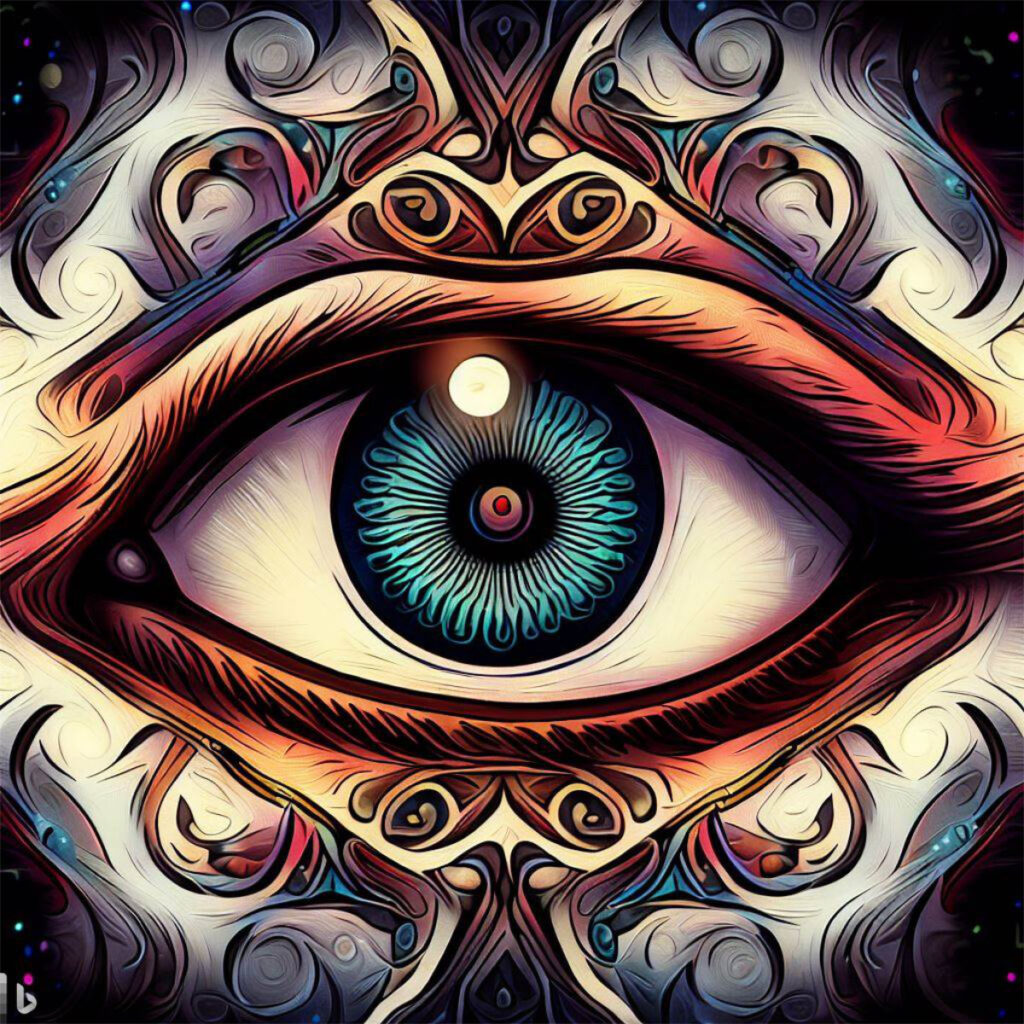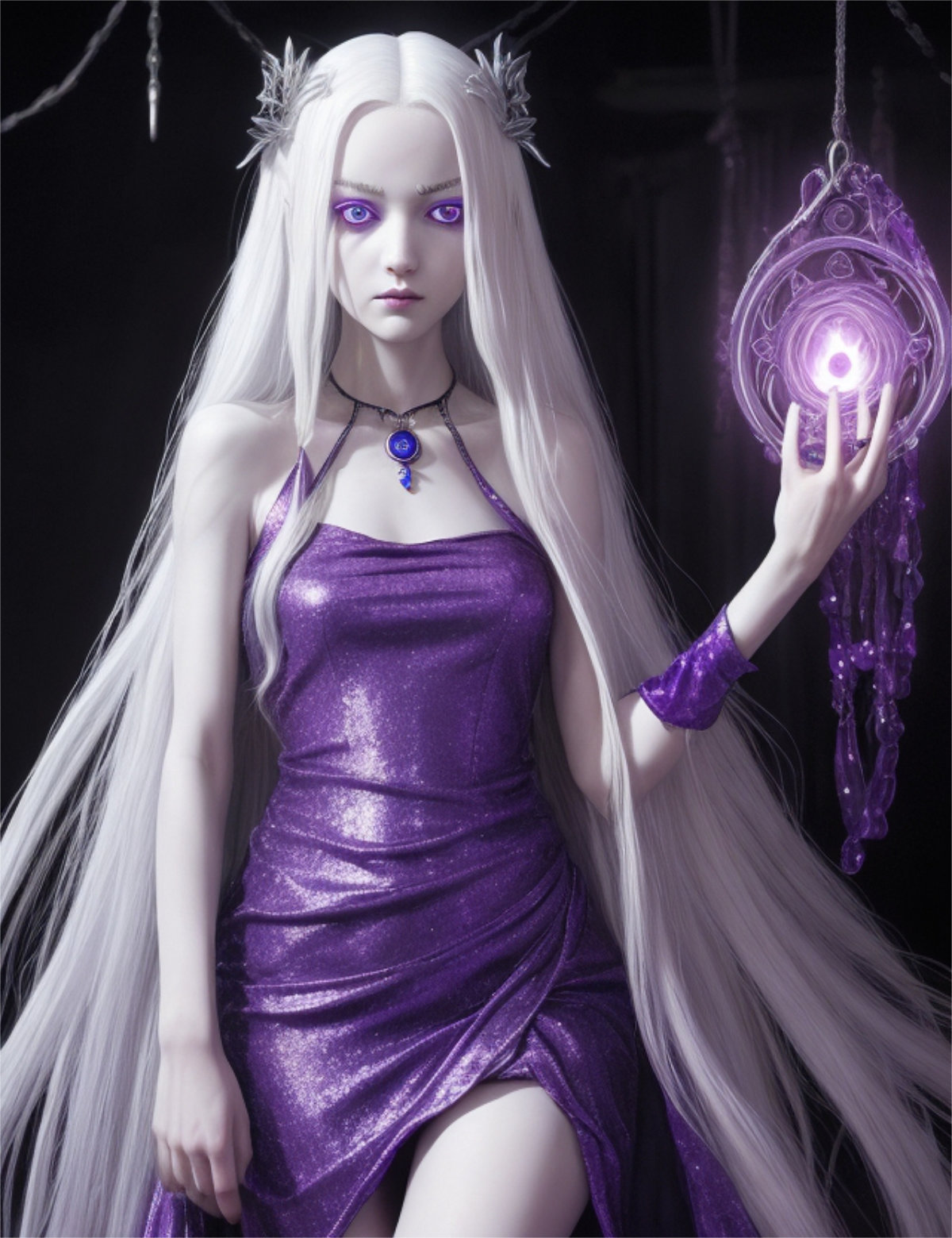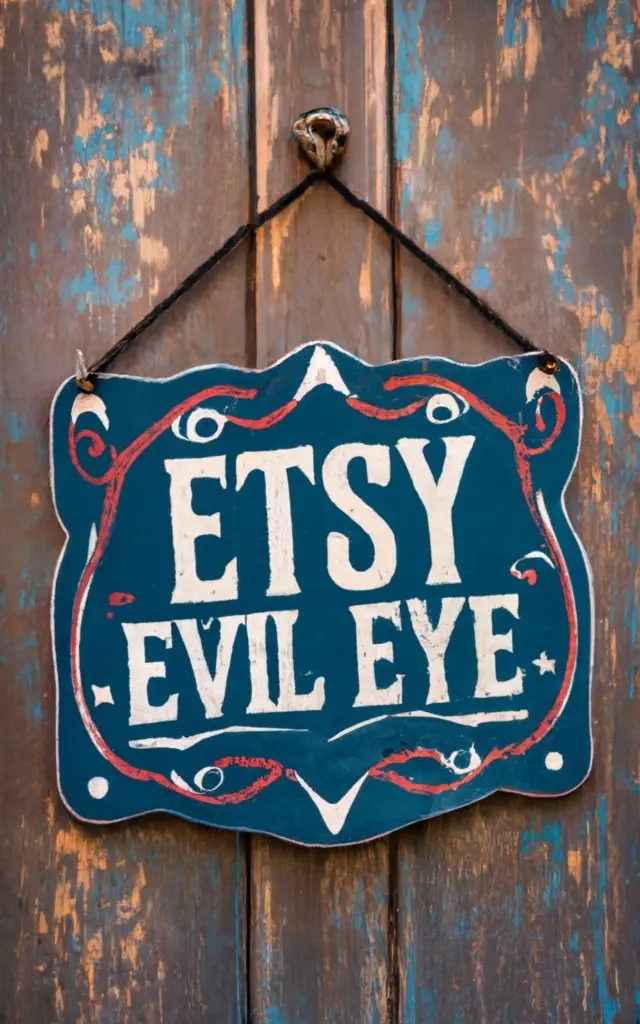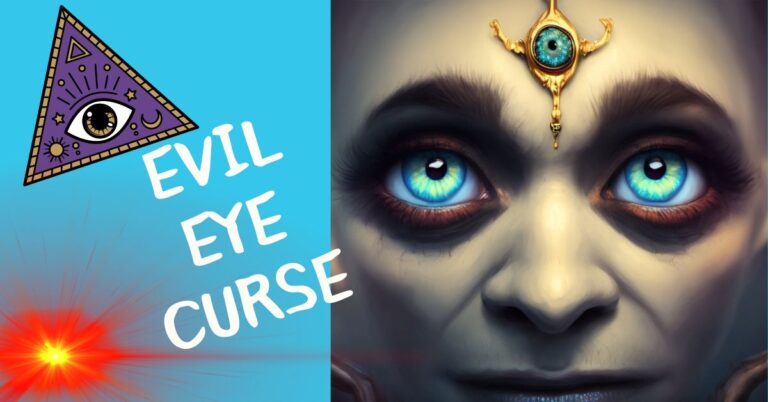Is The Evil Eye Good Or Bad?: Explained
The evil eye is an ancient belief that some people think can bring bad luck, and others believe can be good luck, and this article explores it.
Article Takeaways
Ever felt someone’s stare making you uncomfortable? It might be the evil eye! This old belief, found in different cultures, is interesting and spooky.
In this article, we’ll learn about where the evil eye comes from and why people believe in it. We’ll see how it’s linked to jealousy and how people use special things like amulets to stay safe.
Some people think the evil eye is like a bad spell, while others believe it can be good too. For example, in some places, they use “nazar” eyes to stop bad energy from jealous looks.
In this article, we’ll also talk about how the evil eye affects our feelings and what people do to protect themselves from it. We’ll even see how movies and books make it even more mysterious. So, let’s explore the world of the evil eye together!

Introduction
Is The Evil Eye Good Or Bad? Have you ever had that nagging feeling that someone’s envy or jealousy is affecting your life? Perhaps you’ve heard whispers of the “evil eye” and wondered what it’s all about. Well, in this article, we will delve into this fascinating topic to uncover the truth behind the belief in the evil eye and its cross-cultural perspectives.
Belief systems surrounding the evil eye have deep roots in various cultures across the globe. From ancient customs to modern interpretations, this concept has held significance for centuries.
Its historical origins can be traced back to ancient civilizations such as Mesopotamia and Egypt, where it was believed that individuals possessed a malevolent gaze capable of bestowing blessings or curses upon others. In many folk traditions, the evil eye is seen as a powerful force with both positive and negative impacts.
Some cultures believe that it acts as a protective amulet, warding off negativity and safeguarding against ill fortune. Others view it as a curse that brings misfortune and harm to those who fall victim to its gaze.
Superstitions and folklore suggest that envy and jealousy are at the core of evil eye beliefs. The belief goes that when someone envies another person’s success or happiness, their negative energy can manifest through their gaze, inflicting harm upon the recipient.
This perceived power of perception highlights how deeply ingrained psychological effects can be intertwined with cultural perceptions. While some may dismiss such beliefs as mere superstitions debunked by science, others argue for their cultural significance.
In today’s society, where envy runs rampant on social media platforms showcasing seemingly perfect lives, one cannot deny the impact of comparisons fueled by jealousy. Understanding the phenomenon of the evil eye requires exploring not only its historical origins but also its psychological and cultural implications.
Whether we believe in its power or regard it as an ancient superstition passed down through generations, exploring these folk beliefs offers insights into how they shape our lives today. So, let’s now delve into the intriguing world of the evil eye and explore its many facets.
Unveiling the Mystery: Exploring the Origins and Beliefs Surrounding the Evil Eye!
Exploring the Origins and Beliefs Surrounding the Evil Eye The evil eye, a mystical phenomenon that has captivated cultures worldwide for centuries, remains shrouded in an air of mystery and intrigue. To truly understand its significance, we must embark on a journey through time, unraveling its origins and exploring the beliefs surrounding it.
From ancient customs to modern interpretations, the evil eye holds a unique place in our collective consciousness. Historical origins reveal that belief in the evil eye stretches back thousands of years.
It is deeply rooted in various cultures, each offering its own interpretation of this mystical force. In ancient Greece, for example, it was believed that certain individuals possessed the power to cast curses through their gaze.
This concept transcended borders and influenced neighboring civilizations such as Rome and Egypt. Evil eye beliefs are often intertwined with envy and jealousy—a potent combination attributing tremendous power to our perceptions.
According to cultural perceptions across different societies, if someone casts a covetous glance upon another person or their possessions out of jealousy or resentment, it may bring misfortune or even harm to them. This fear led people to develop elaborate rituals and protective amulets as folk traditions aimed at warding off negativity associated with the evil eye.
Superstitions surrounding the evil eye have persisted throughout history despite attempts at debunking them with scientific explanations. While some may dismiss it as mere folklore or superstition today, many communities around the world continue to place great cultural significance on this belief system.
From Latin American countries where mal de ojo (evil eye) is an integral part of folk beliefs to Middle Eastern cultures where Nazar (a blue talisman) is used for protection against malevolent looks, cross-cultural perspectives on the evil eye remain diverse yet interconnected. As we delve further into understanding this enigmatic phenomenon, we will explore how different cultures perceive its dual nature—sometimes as a benevolent blessing and other times as a malevolent curse.
By examining the historical origins, cultural beliefs, and psychological effects associated with the evil eye, we can gain a deeper insight into its complexities. In doing so, we will unravel the layers of this intriguing mysticism that has captivated humanity for centuries.
The historical and cultural roots of the evil eye belief, shed light on its significance in various societies.
The evil eye belief is deeply rooted in the folk traditions and superstitions of many cultures around the world. To truly understand its significance, it’s necessary to delve into its historical origins and cultural perceptions. Ancient customs and belief systems play a vital role in shaping these traditions, making it a fascinating topic to explore.
One of the earliest documented instances of the evil eye can be traced back to ancient Greece, where it was believed that certain individuals had the power to cast curses through their envious gaze. This belief spread across various Mediterranean cultures, including Ancient Rome and Byzantium.
In these societies, people were wary of attracting envy or jealousy from others, as it was believed that this could lead to misfortune and harm. Folk beliefs surrounding the evil eye also found their way into other cultures over time.
In some Middle Eastern countries like Turkey and Iran, for example, protective amulets known as “nazar” are commonly used to ward off negativity caused by jealous gazes. These amulets often take the form of an eye symbol with vibrant colors, serving as a visual deterrent against any potentially harmful energies.
The psychological effects associated with the evil eye belief are intriguing as well. The fear of attracting jealousy or envy from others can have a profound impact on individuals’ mental well-being.
It creates a heightened sense of vigilance and prompts people to take precautionary measures such as avoiding boasting about their successes or possessions in order to minimize attention from potential “evil eyes.” This aspect demonstrates how deeply ingrained the belief is within certain cultural contexts, highlighting its ongoing significance in modern interpretations. Ultimately, exploring the historical origins and cultural significance of evil eye beliefs provides us with valuable insights into our collective human experience.
These beliefs offer glimpses into how our ancestors perceived envy and jealousy as potent forces capable of causing harm or bringing blessings upon individuals. By understanding these cross-cultural perspectives on the evil eye, we gain a deeper appreciation for the diverse ways in which societies have sought to protect themselves from negative energies and maintain a sense of well-being.
The Power of Perception: Understanding How the Evil Eye Works!
Superstitions and folklore have long intrigued humanity, offering glimpses into our collective beliefs and fears. One such intriguing belief is that of the evil eye, a notion deeply rooted in cultural significance across many societies.
At its core, the concept revolves around the power of perception – how the gaze of envy and jealousy can manifest as a curse upon individuals. This belief rests on the idea that certain individuals possess an innate ability to impart blessings or curses through their mere gaze.
The psychological effects associated with the evil eye are fascinating to explore. When someone believes they have fallen victim to the evil eye, it can lead to feelings of unease, anxiety, and even physical discomfort.
The person afflicted may experience a series of misfortunes or setbacks ascribed to this malevolent gaze. In some cases, these effects may be purely psychological manifestations resulting from heightened stress and anxiety induced by cultural perceptions surrounding this phenomenon.
Cross-cultural perspectives shed light on the various interpretations of this pervasive belief. While some cultures view it exclusively as a malicious curse, others perceive it as a protective force against harm.
Folk traditions abound with rituals aimed at warding off negativity caused by jealous glances. Protective amulets featuring symbols like eyes or hands are commonly worn or displayed in homes to counteract any potential harm from an envious stare.
Modern interpretations offer alternative perspectives on the evil eye’s workings, often seeking rational explanations rooted in science rather than superstition debunked by logic. Some experts argue that belief in the evil eye stems from primal instincts related to group dynamics and survival pressures throughout history.
Understanding how this ancient custom persists in contemporary times requires delving into its complex tapestry of historical origins, folk beliefs, and cultural perceptions. Whether one chooses to approach it with skepticism or open-mindedness, exploring the power of perception underlying the evil eye remains a captivating journey into human psychology and belief systems.
Explore the psychology behind the evil eye concept.
Belief in the evil eye has persisted for centuries across different cultures, and its psychological effects continue to intrigue scholars and psychologists alike.
At its core, the evil eye phenomenon revolves around envy and jealousy, two powerful emotions that can deeply impact individuals and their overall well-being. Modern interpretations suggest that these feelings of jealousy and envy can have profound psychological consequences on both the sender and receiver of the malevolent gaze.
Psychologists argue that envy stems from a deep-rooted desire for what others possess. When someone feels envious, it often triggers a sense of inadequacy or resentment towards those who possess what they covet.
This emotional turmoil can lead to negative thoughts and behaviors, as individuals may struggle with feelings of unworthiness or bitterness. In relation to the evil eye beliefs, it is believed that when someone directs intense envy towards another person, it manifests as a destructive energy or curse capable of causing harm.
Superstitions and folklore surrounding envy have played an essential role in shaping evil-eye beliefs across different cultures. Ancient customs sought to protect against this malevolent gaze through various rituals and amulets.
Folk traditions often emphasized warding off negativity by using talismans like blue beads or hamsa symbols to deflect jealous glances. These customs demonstrate how deeply ingrained cultural perceptions of envy have shaped our understanding of the evil eye phenomenon.
In some belief systems, blessings and curses were thought to hold immense power over people’s lives. The belief in curses generated fear among individuals who worried about attracting ill fortune through someone’s envious gaze.
Conversely, being blessed was seen as protection against such harmful influences. This intricate interplay between emotions like envy, beliefs in blessings and curses, and folk traditions involving protective amulets or rituals reveals how cultural perceptions shape our understanding of this mysterious phenomenon: the evil eye.
If you enjoyed this informative article I know you will love:
Evil Eye Bracelet Color Meaning: How Colors Influence Your Life!
Good or Bad? The Dual Nature of the Evil Eye in Different Cultures!
Belief in the evil eye is not a monolithic concept; its interpretation varies greatly across different cultures. While some societies view it as a protective talisman, others consider it a curse capable of bringing misfortune and harm. The dual nature of the evil eye is deeply rooted in cultural perceptions and belief systems that have evolved over centuries.
In certain cultures, envy and jealousy are seen as negative emotions that can potentially harm others through the channeling of negative energy. The evil eye, in this context, becomes a way to explain and protect against the potential damage caused by these emotions.
Folk traditions often emphasize the importance of warding off negativity and protecting oneself from the malevolent intentions of others. Conversely, there are cultures where the evil eye is seen as more than just a curse; it also holds blessings within its gaze.
Here, the belief is that those who possess an exceptionally powerful or captivating presence have the ability to bestow good fortune upon others through their “lucky” gaze. This perspective suggests that while envy may exist, it can also be transformed into positivity and abundance.
The historical origins of these beliefs date back thousands of years and are steeped in ancient customs and folklore. Superstitions surrounding the evil eye have been passed down through generations, shaping cultural perceptions on both an individual and societal level.
From Mediterranean countries like Greece and Turkey to Middle Eastern countries like Lebanon and Egypt, various rituals and amulets are employed to fend off any potential harm caused by this perceived malevolence. Understanding the dual nature of the evil eye requires acknowledging both its superstitious aspects as well as its modern interpretations within different cultural frameworks.
While skepticism may arise when trying to find scientific evidence supporting the existence or power of curses or blessings associated with this belief, it’s important to recognize that folk beliefs often transcend rationality. Whether viewed as a harbinger of misfortune or an instrument for bestowing blessings, the interpretation of the evil eye varies significantly across cultures.
While some perceive it as a curse to be avoided, others see it as a powerful force that can bring fortune and prosperity. Regardless of one’s stance on its veracity, the cultural significance and historical origins of these beliefs cannot be denied.
Investigate how different cultures perceive the evil eye.
Investigating how different cultures perceive the evil eye provides a fascinating glimpse into the diverse ways this phenomenon is understood and interpreted worldwide. Cross-cultural perspectives on the evil eye range from viewing it as a protective talisman to considering it a harmful curse.
This section explores various instances where these opposing beliefs manifest. In many cultures, particularly in the Middle East and Mediterranean regions, the evil eye is regarded as a powerful talisman for protection against malevolent forces.
People often wear amulets or charms, such as the Nazar Boncuk, to ward off negativity and attract blessings. This belief stems from ancient customs and folk traditions that emphasize the cultural significance of protecting oneself from envy and jealousy.
The Nazar Boncuk, with its vibrant blue color symbolizing power and luck, is believed to absorb negative energy directed towards its wearer. Conversely, in certain societies, the evil eye is seen as a curse capable of causing harm or misfortune.
Some cultures attribute personal or societal woes to this supposed curse cast by others’ jealous gazes. In these belief systems, individuals who possess an appealing quality or possess great success are considered particularly vulnerable to misfortune caused by envy.
Superstition debunked or not, this fear of the negative effects of envy has persisted across generations. Modern interpretations have also emerged regarding how different cultures perceive the evil eye’s dual nature.
Some interpret it metaphorically rather than literally—seeing it as a reflection of psychological effects rather than actual curses or blessings. This perspective suggests that belief in the evil eye can exacerbate feelings of paranoia or insecurity among individuals who constantly worry about being affected by jealousy or envy.
Overall, examining various cultural perceptions of the evil eye sheds light on how folklore and beliefs shape people’s understandings of good versus bad fortune. From protective amulets to cautionary tales about curses born out of envy, these diverse interpretations offer invaluable insights into humanity’s age-old fascination with the unseen forces that impact our lives.
Warding Off Negativity: The Role of Amulets and Rituals Against the Evil Eye!
Throughout history, various cultures have developed unique customs and rituals to protect themselves from the malevolent gaze of the evil eye.
These practices often involve the use of amulets and talismans believed to possess mystical powers capable of warding off negative energy. Cultural perceptions surrounding the evil eye play a significant role in shaping these beliefs and practices.
In many folk traditions, amulets hold great importance as protective charms against the evil eye. These amulets can take many forms, varying from region to region.
One common type is the hamsa hand, a symbol depicting an open palm with an eye in its center. It is believed that this ancient symbol not only guards against the evil eye but also brings blessings and good luck.
Another popular amulet is the nazar, which features a blue glass bead with an eye design. It is thought to absorb any malevolent energy directed towards its wearer.
But it’s not just protective objects that hold significance; rituals also play a crucial role in safeguarding against the evil eye’s influence. For instance, in Greek culture, breaking a mirror is considered a way to deflect any negative energy or curses associated with jealousy or envy.
Similarly, burning herbs like sage or performing smoke cleansing rituals are believed to purify spaces and rid them of any evil influences. These practices extend beyond specific cultures; they exhibit cross-cultural perspectives that emphasize our shared belief in protecting ourselves from harm.
While some may dismiss these rituals as mere superstitions and folklore, their psychological effects cannot be denied. Belief systems are deeply ingrained within societies, shaping individual behavior and providing comfort amidst uncertainty.
Whether these practices truly possess supernatural powers or operate solely on psychological grounds remains debated, but their cultural significance cannot be overlooked. As we navigate through modern interpretations of ancient customs and beliefs surrounding the evil eye, it becomes evident that these practices continue to hold relevance in contemporary society.
While some may view them as outdated superstitions, others find solace and a connection to their cultural heritage through them. Whether through a cherished amulet worn daily or the performance of rituals during important life events, the desire to protect oneself from negativity remains a persistent aspect of human existence.
The various protective measures people employ to guard against the evil eye.
When it comes to protecting oneself from the potential malevolence of the evil eye, people across various cultures have devised a range of intriguing and diverse measures. From wearing amulets to performing intricate rituals and ceremonies, these practices are deeply rooted in cultural significance and historical origins.
It is fascinating how such folk beliefs and superstitions continue to influence our actions even in modern times. In many belief systems, amulets play a crucial role in guarding against the evil eye’s harmful effects.
These protective charms can take various forms, such as an eye-shaped pendant or a small piece of jewelry adorned with symbols representing blessings and curses. For instance, the nazar amulet, commonly found in Turkish culture, is believed to deflect negative energy caused by jealousy or envy.
Similarly, in Greek folklore, the mati or “evil eye” charm is often worn as a necklace or bracelet as a means of warding off negativity. Moreover, within different cultures, intricate rituals and ceremonies are performed to counteract the potential harm caused by the evil eye.
These practices often involve the recitation of prayers or invocations while using specific objects or substances believed to possess protective properties. For example, burning herbs like sage or palo santo is common in many indigenous traditions as part of cleansing rituals aimed at removing negative energies brought about by jealousy or ill intentions.
It is remarkable how these ancient customs have persisted over time due to their cross-cultural perspectives on combating the perceived influence of envy and jealousy. While some may dismiss these practices as mere superstition debunked by modern interpretations and scientific explanations, others continue to hold onto their beliefs in these folk traditions for their perceived protective power against the perils of the evil eye.
People employ various protective measures against the evil eye that reflect both cultural perceptions and historical origins. Wearing amulets like nazar pendants and mati charms has become ingrained within certain societies’ belief systems as a means of warding off negativity and deflecting the potential harm caused by jealousy or envy.
Additionally, performing rituals and ceremonies using specific objects or substances carries a significant role in protecting against the perceived malevolence of the evil eye. While some may view these practices as mere superstitions, they continue to hold cultural significance and provide people with a sense of security in an unpredictable world.
Science vs. Superstition: Analyzing the Rational and Irrational Aspects of the Evil Eye Belief!
In examining the rational and irrational aspects of the evil eye belief, it becomes apparent that this topic straddles the line between science and superstition. On one hand, there are scientific explanations attempting to debunk the notion of a malevolent gaze possessing supernatural powers.
On the other hand, there is a long-standing cultural history surrounding this belief that cannot be easily dismissed. From a scientific standpoint, the evil eye can be seen as a product of our psychological makeup.
Envy and jealousy are natural human emotions, and their negative effects on individuals can manifest in various ways. The evil eye belief provides an explanation for why some people experience misfortune or ill health after being subjected to envy or jealousy from others.
In this sense, it can be viewed as a psychological phenomenon rather than an actual supernatural force. However, it is important to recognize that dismissing the evil eye solely as superstition overlooks its deep cultural significance.
Across different belief systems and cultures, warding off negativity through amulets and rituals has been an integral part of folk traditions for centuries. These practices may not have any basis in scientific fact, but they hold tremendous meaning for those who adhere to them.
The power lies in the collective faith of communities who find solace in these ancient customs. Moreover, modern interpretations of the evil eye have emerged that bridge both rationality and mysticism.
Some argue that while there may not be tangible evidence for its existence, the evil eye serves as a metaphorical reminder to be mindful of our actions and intentions toward others. It encourages self-reflection and fosters empathy by highlighting the potential harm we can inflict when driven by envy or jealousy.
Ultimately, understanding the rational and irrational aspects of the evil eye belief requires acknowledging its historical origins rooted in cultural perceptions while also considering scientific explanations surrounding envy’s psychological effects. Whether one chooses to view it purely as folklore or embrace its protective qualities is subjective; what matters most is respecting the beliefs and experiences of those who hold it dear, as the human experience is often intertwined with a tapestry of both reason and mysticism.
The scientific and psychological explanations for the evil eye belief and considers its place in modern society.
The scientific and psychological explanations for the evil eye belief have been subjects of great interest and debate among scholars and researchers. While some dismiss it as mere superstition, others delve deeper into understanding the cultural perceptions and belief systems that underlie this phenomenon. From a psychological standpoint, the evil eye belief can be seen as a manifestation of envy and jealousy.
These emotions are universal human experiences, and throughout history, people have attributed negative effects to these feelings. The idea behind the evil eye is that intense envy or jealousy directed towards someone can harm them or bring about misfortune.
This perception taps into our innate fear of ill-wishing and the potential consequences it may entail. On a scientific level, some explanations consider the evil eye belief as a form of projection or self-fulfilling prophecy.
When individuals believe they are being affected by someone’s malevolent gaze, they may start to experience negative psychological effects such as anxiety, stress, or even physical symptoms. These effects could be attributed to the power of suggestion rather than any supernatural force at play.
In modern society, the evil eye belief has taken on new interpretations and meanings. Some view it purely through a cultural lens, appreciating its historical origins and its significance in ancient customs.
Others see it as an interesting folk tradition worth exploring for its cultural richness. However, with increasing skepticism towards superstitions and folklore in general, many view the evil eye belief as an outdated concept with no place in contemporary life.
As cross-cultural perspectives come into play, we witness variations in how different societies interpret this phenomenon. While some cultures perceive it solely as a curse to be warded off with protective amulets or rituals meant to counteract its effects, others see it as a form of divine blessing that brings good fortune instead of harm.
Examining scientific and psychological explanations for the evil eye belief offers us insights into how our beliefs shape our perceptions of reality. While some dismiss it as superstition, others appreciate its cultural significance and historical origins.
Ultimately, its place in modern society is subjective and depends on one’s personal views. Whether viewed as a powerful force or debunked as psychological suggestion, the evil eye belief continues to captivate our curiosity and ignite conversations about the mysterious aspects of human belief systems.
The Evil Eye in Pop Culture: How Movies and TV Shows Portray this Mystical Phenomenon!
In today’s entertainment landscape, the evil eye has become a captivating subject that filmmakers and TV producers love to explore. From supernatural thrillers to fantasy epics, the depiction of this mystical phenomenon in movies and television shows adds an element of intrigue and suspense.
Ancient customs and beliefs surrounding the evil eye provide fertile ground for creative storytelling, allowing writers and directors to weave tales that captivate audiences around the globe. Movies often portray the evil eye as a powerful force that brings both blessings and curses.
This duality is exemplified in films like “The Eye,” where Jessica Alba’s character gains the ability to see through other people’s eyes but also becomes plagued by sinister visions. Such narratives tap into our fascination with cross-cultural perspectives on the evil eye, showing how different belief systems interpret its effects on individuals.
The psychological effects of envy and jealousy are also commonly explored, giving viewers a glimpse into how these emotions can manifest as supernatural phenomena. Superstitions and folklore related to the evil eye are frequently woven into plotlines, offering viewers a deeper understanding of cultural significance.
For instance, in “Evil Eye,” a recent Amazon Prime film based on Indian folklore, an overprotective mother suspects her daughter’s boyfriend has cast an evil eye upon her. This exploration of folk traditions not only adds depth to storytelling but also introduces audiences to lesser-known cultural perceptions surrounding the evil eye.
Modern interpretations of the evil eye have also found their place in popular culture. In shows like “Charmed” or “Supernatural,” characters use amulets or perform rituals as a means of warding off negativity caused by this malevolent gaze.
These protective amulets often draw inspiration from ancient customs associated with warding off the evil eye, showcasing how folk beliefs have influenced modern practices. Overall, movies and TV shows provide platforms for the exploration and portrayal of the evil eye, allowing us to delve into its historical origins, cultural significance, and psychological impact.
By incorporating elements from ancient customs, superstitions, and folklore, these visual narratives deepen our understanding of this mystical phenomenon. Whether they serve as cautionary tales or simply entertain us with fantastical interpretations, these portrayals leave an indelible mark on our collective imagination.
Explore the representation of the evil eye in popular media and discuss how it influences public perception and understanding.
The representation of the evil eye in popular media has had a significant impact on public perception and understanding of this mystical phenomenon. From movies to TV shows, the evil eye has been portrayed in various ways, often perpetuating both the fascination and fear associated with it. These portrayals have shaped the collective imagination around the evil eye and influenced how people perceive and interpret its meanings.
In many films and television series, the evil eye is depicted as a powerful force capable of wreaking havoc on individuals or entire communities. These representations often draw upon ancient customs, folk beliefs, and cultural perceptions surrounding the evil eye.
Whether it’s a character casting curses with just a glare or the use of protective amulets to ward off its malevolent effects, these portrayals tap into deep-rooted superstitions and folklore. However, it’s important to recognize that these depictions are often dramatized for entertainment purposes rather than reflecting accurate beliefs or practices.
While some may argue that these representations perpetuate superstition debunked by modern interpretations, others see them as an integral part of preserving cultural heritage and belief systems. The influence of popular media can be seen in how people interpret real-life experiences related to the evil eye.
For instance, someone might attribute their misfortunes to being cursed by an envious gaze after being exposed to such portrayals. Conversely, others might dismiss such occurrences as mere coincidences or psychological effects influenced by their own beliefs.
Ultimately, while popular media plays a role in shaping public perception of the evil eye, it’s essential to approach these representations with critical thinking and an understanding of cross-cultural perspectives. By exploring both historical origins and modern interpretations surrounding this belief system, we can gain a more nuanced understanding that goes beyond fictionalized portrayals seen on screen.
Conclusion for Is The Evil Eye Good Or Bad?
So, to sum it all up, the evil eye is a really interesting belief that people have had for a very long time. It’s all about when someone gets jealous of another person and their jealousy can kind of make bad things happen.
We learned that this belief goes way back to ancient times, and different cultures have different ideas about it. Some think it’s like a lucky charm that keeps bad things away, while others believe it’s like a curse that can bring trouble.
We also found out that jealousy and how we compare ourselves to others can have a big impact on how we feel. In today’s world, especially on social media, we often compare ourselves to others, and that can sometimes make us feel bad.
So, whether we think the evil eye is real or just an old superstition, it’s cool to learn about because it helps us understand how people and their beliefs shape the world around us. It’s a bit like a mystery that we can keep exploring.
5 Frequently Asked Questions
- What is climate change, and why is it a concern?
- Climate change refers to long-term shifts in temperature, weather patterns, and environmental conditions on Earth. It’s a concern because it’s largely caused by human activities like burning fossil fuels, deforestation, and industrial processes, leading to rising global temperatures, extreme weather events, and environmental disruptions.
- How does a computer work?
- Computers work by processing information using a combination of hardware (like the central processing unit and memory) and software (programs and operating systems). They use binary code (0s and 1s) to store and manipulate data, enabling tasks like calculations, data storage, and running software applications.
- What is the importance of recycling?
- Recycling is essential because it helps reduce waste, conserve natural resources, and decrease pollution. When we recycle materials like paper, glass, and plastics, we use them again to make new products, which saves energy and reduces the need for raw materials.
- How do plants make food through photosynthesis?
- Plants make food through a process called photosynthesis. They use sunlight, carbon dioxide from the air, and water from the soil to create glucose (a type of sugar) and oxygen. This process happens in the chloroplasts of plant cells, and it’s essential for plant growth and the production of oxygen in our atmosphere.
- What are the effects of regular exercise on the body?
- Regular exercise has numerous positive effects on the body. It helps improve cardiovascular health, strengthen muscles and bones, boost the immune system, reduce the risk of chronic diseases like diabetes, and enhance mental well-being by releasing endorphins, which are natural mood lifters.
If you enjoyed this article I know you will love Evil Eye | Feng Shui For Your Home: 14 Tips For Your Protection.
If you enjoyed this informative article I know you will love:
Evil Eye Bracelet Color Meaning: How Colors Influence Your Life!
- Jewelry Making Ideas: Seasonal Crystal Trends That Command Premium Prices - May 31, 2025
- Evil Eye Hand: Unveiling the Mystical Origins and Meanings - February 2, 2024
- Amegreen Amethyst Meaning: Discover the Hidden Magic! - February 2, 2024








